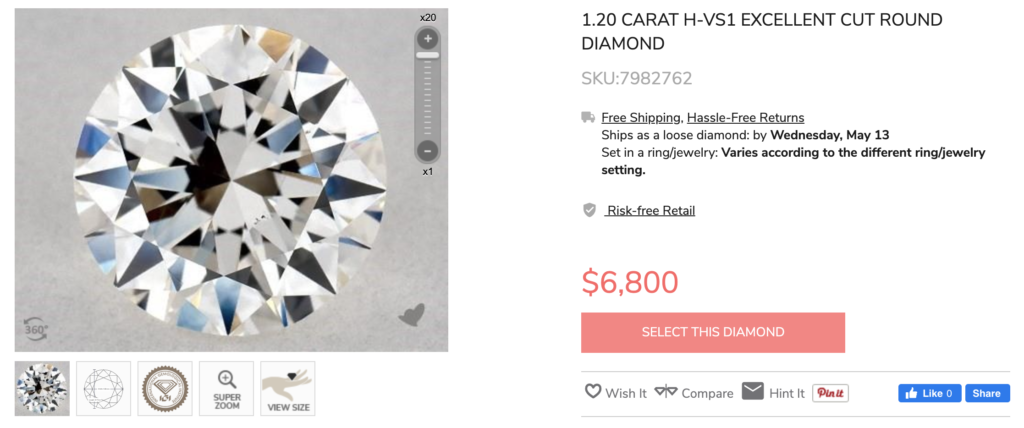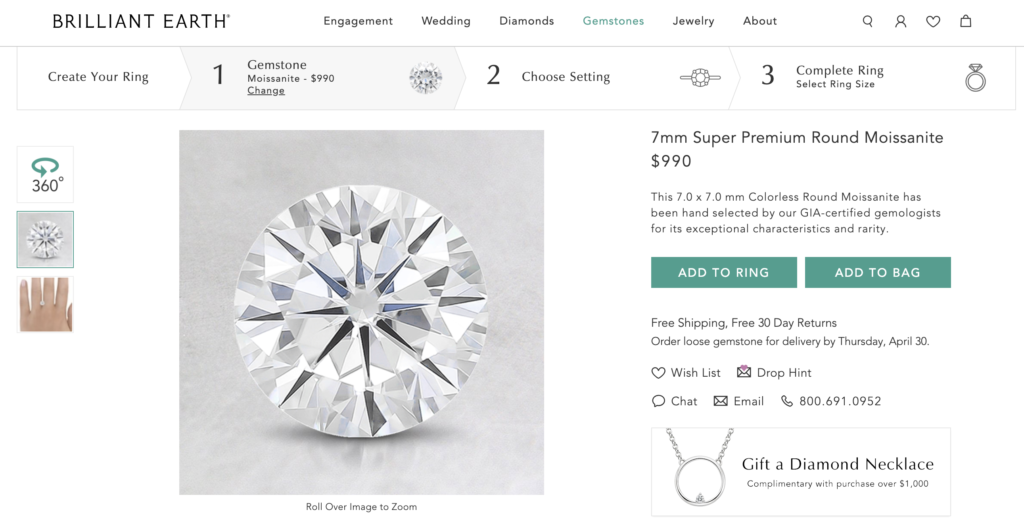While diamonds are clearly far more popular among couples when it comes to engagement rings, moissanite is attracting a lot of attention.
There are several reasons for the increased interest in moissanite as a center stone in an engagement ring:
- Cost of moissanite is much less, compared to diamonds. See the example just below.
- Light performance is similar. Moissanite gemstones have plenty of sparkle.
- Moissanite has a beautiful history. They arrived first only on meteors from space. More recently, the most amazing species we know figured out how to make them in labs.
- Their hardness is 9.25 on the Mohs scale of hardness, just behind diamond’s perfect 10. (That doesn’t mean they’re 9/10 as hard as diamonds. They’re a little less than half as hard as diamonds. More on that below.)
How Much Does Moissanite Cost Compared to Diamonds?
One of the first things people want to know about moissanite is the cost. How much does a moissanite stone cost, compared to a diamond of the same size?
The answer can be very complex, depending on the quality of the diamond.
But the answer can also be pretty simple, if we choose an average quality diamond.
We’ll do it the simple and effective way.
Cost Comparison of Average Quality Diamond With Superb Quality Moissanite
We’ll compare two 7mm gemstones. One a diamond, and one a moissanite.
A 7mm round diamond weighs 1.2 Carats, according to this useful chart.
A 7mm round moissanite gemstone weighs 1.1 Carats.
Let’s say our sample diamond has the following GIA grades:
- Color: H (That’s well down the color scale, but one that’s often used with Round Brilliant Cuts.
- Clarity: VS2 (Very slightly included. Means it has a very few flaws. Again, this is a selection shoppers use to keep the cost of the diamond a little lower than it would otherwise be.)
- Cut Quality: Good (Again, we’re aiming for a middle-of-the-road, decent diamond, not cheap but not the most expensive we could find.)
Such a diamond, you’ll find if you search at any reputable diamond retailer, will cost you about $6,500 to $7,000 for the gemstone alone.
Here is a diamond with those exactly specs from James Allen for $6,800.

What about the moissanite of the same size?
This comparable moissanite is $990, from Brilliant Earth.

That’s an exceptionally beautiful moissanite.
And do notice, almost all moissanite is, since it is all created in the lab. The color, the clarity, and the cut are all comparable to or better than the diamond. (More on that below.)
Meteor-arrived moissanite exists. But that’s only in theory, as far as its availability. It’s so rare that it’s traded only among extremely wealthy and well-connected people. You won’t find it in an online store, or any typical jewelry store.
So the moissanite wins easily, when it comes to cost.
- 7mm 1.2-Carat Diamond: $6,500
- 7mm 1.1-Carat Moissanite: $990
Light Performance and Appearance – Moissanite vs Diamond
It pains people who love diamonds to admit it, so it pains me. But it’s just true: most people can’t easily tell the difference between moissanite and diamond.
It gets even worse — or should I say better? Sometimes even trained gemologists have difficulty in telling the difference between moissanite and diamond.
Worst — or best — of all, sometimes even specialized equipment known as “diamond testers” can misidentify the two.
Diamond testers (the equipment) that test thermal conductivity often misidentify moissanite as diamond.
Diamond testers that test also for electrical conductivity will note the difference.
The trained human eye, using a jeweler’s loupe, may be the best way to detect that a gemstone is moissanite, not diamond.
Here’s how you would do it:
You look for “double refraction” as a telltale sign that a gemstone is not diamond. (Other gemstones such as sapphire, not only moissanite, also exhibit “double refraction.” )
What Is Double Refraction in Moissanite?
Essentially, that means in moissanite, the rainbow effects come through the crown facets as well as the table facet, when viewed from certain angles. This is not a simple test to perform, unless you’re trained and experience and know how to look for it.
Also, you’d need to be even more experienced when it came to other cuts. For example, Asscher cuts, marquise cuts, and so on.
In a well-cut round brilliant diamond, the rainbow effects (the “fire”) comes only through the table (the top center facet).
To sum up the light performance of moissanite:
- Brilliance: moissanite can match diamonds, in the eyes of all but experts.
- Fire (rainbow effects): moissanite may overdo it a little, marking it as “fake”. Some people like the extra fire. Some people don’t. Almost everyone can’t even tell the difference.
Lab-Created Moissanite vs a Billion Year Old Diamond
One consideration, from an emotional point of view, is that all moissanite available is lab-created. But most diamonds in stores are naturally occurring.
Some people absolutely prefer the billion year old natural stone. It was here before our species. Now that is forever. Plus, it’ll be here forever after us as well.
Especially the origin in the deep past is very touching, spiritually romantic, for many people.
On the other hand, the consciousness and ingenuity of human beings is an incredible thing to connect to as well. We built that.
Plus, lab-created gemstones, whether diamond or moissanite, are perceived by many people as more environmentally friendly, and they like that.
Ultimately, it comes down to you and your beloved.
Accents Must Be Diamonds
Moissanites aren’t usually cut in small enough sizes to use as tiny accents. Larger side stones, yes. But the tiny sparkling accents for a halo setting, or a pavé setting? You’ll need to use diamonds.
It’s not difficult to find engagement rings for sale which have a moissanite center stone and diamond accents.
Hardness and Durability of Moissanite Engagement Rings
Moissanite is very durable, scoring a 9.25 on the Mohs hardness scale, which is close behind diamond at 10.
Simply put, moissanite will last lifetimes.
However, just be aware that diamonds are slightly more than twice as hard as moissanite.
How does that work? Moissanite is 9.25 while diamond is 10 on the Mohs scale.
It’s because the Mohs scale is just an ordered scale. In the 19th Century, Friedrich Mohs tested minerals by scratching them with each other. Then he put them in a pecking order. Diamond is 10 as the hardest. Talc is 1 as the softest.
But Mohs in 1812 did not have the technical means for measuring actual hardness. Today we do.
One way we express that is on what’s known as the Knoop hardness scale.
- On the Knoop hardness scale, diamond is 7,000
- On the Knoop hardness scale, moissanite is 2,925
That still means that moissanite is very very hard, and very very durable.
But you wouldn’t want to, for example, mount a moissanite stone between two diamond side stones, and then clean the ring one day in an ultrasonic cleaning machine.
The diamonds vibrating against the moissanite could certainly chip and damage it.
(Diamonds will even damage each other sometimes in an ultrasonic cleaner. That’s why I recommend an ultrasonic cleaner be used only if gemstones are absolutely not touching each other in the setting.)
How Does the Clarity of Moissanite Compare to Diamonds?
Most moissanite is of virtually flawless clarity. We can’t say the same of diamonds, even lab created diamonds.
This fact can save more than money. It can save you time, if you have decided that you want a moissanite center stone for an engagement ring.
Much of the effort involved in diamond shopping is sorting through many gemstones to find one with the clarity you like (or can live with) at a price you can afford.
With moissanite, all that effort is unnecessary. You do need to examine any gemstone you buy for clarity, including moissanite. Even at $900 or so, that’s a lot of money. So don’t lose your vigilance.
But chances are very very high that you’ll find virtually all moissanite stones are nearly flawless.
How Does the Color of Moissanite Compare to Diamond?
Just as with the ease of shopping for clarity, moissanites are also easy when it comes to color.
There are no GIA (Gemological Institute of America) or AGS (American Gem Society) grade reports available for any moissanite, of course.
But manufacturers of moissanite do create moissanite of specific color qualities.
Charles and Colvard (C&C) are the world’s biggest manufacturer of moissanites. Let’s look at their color quality levels quickly.
- Forever Classic. The least expensive. Comparable to a GIA grade of K in diamonds.
- Forever Brilliant. Mid-range priced moissanites. This color is comparable to the color of diamonds with a GIA grade of H.
- Forever One. This color of moissanite is comparable to near-colorless diamonds of GIA grade D-E. (Remember that the GIA color scale begins with D as the perfect score. There is no A, B, or C.)
What Shapes Are Moissanite Gemstones Available In?
Moissanite gemstones for engagement rings are available in every shape that diamonds are available in.
They’re especially easily available in Round, Cushion, Oval, and Princess cuts.
How Big Should You Go With a Moissanite Engagement Ring?
There’s a temptation, when shopping for moissanite engagement rings, to max out and get a watermelon sized rock.
But if you think that through, you’ll probably agree with me that it might be a mistake. Or at least you’d probably agree that you should consider the decision carefully.
It all depends on you, your beloved, and your social circle. And the social circles you anticipate moving in for the next 50 years.
The thing is, if you and your beloved are teachers, for example, then you may not want a ginormous engagement ring. It could look like you’re faking having a giant diamond.
What if you just honestly love moissanite? Some people do.
What if you love it because you respect the human ingenuity that created it?
Or what if you love it because the mineral first arrived here from space?
Even then, it’s important to consider how other people may perceive a giant 6-carat stone on her finger.
In Hollywood or on Wall Street, that’s one thing. In ordinary circumstances, a rock that big has an entirely different effect.
People might think it’s overdone. Plus, the only way most people will be able to distinguish a moissanite from a diamond is if its ridiculously big.
Conclusion
There’s no real substitute for a diamond, especially natural diamonds.
But if there were, it would be moissanite.
For all practical purposes, it’s almost as hard. It’s as colorless, or more. It’s as clear, or better. Moissanite does suffer a bit in light performance, in one test: it creates double refractions. Diamonds don’t.
But most people find moissanite to be hard or impossible to distinguish from diamonds.
If you want my feedback on a specific question about moissanite gemstones or diamonds, don’t hesitate to contact me. I’m here to help you find the engagement ring you want at a price you can afford.
